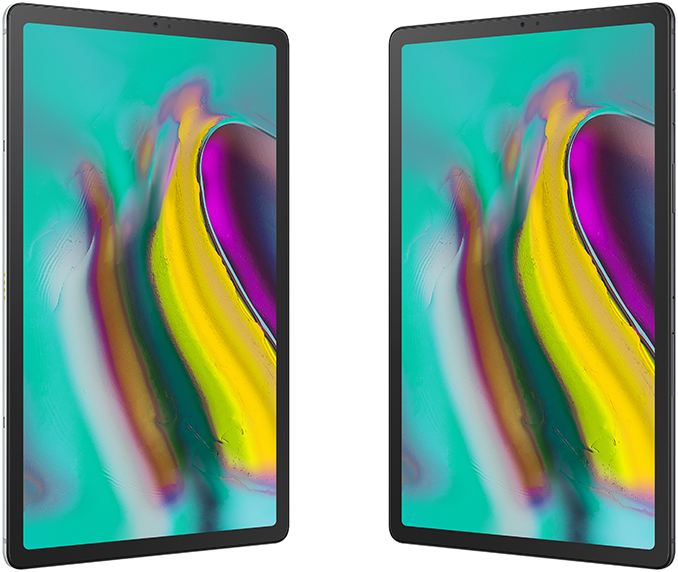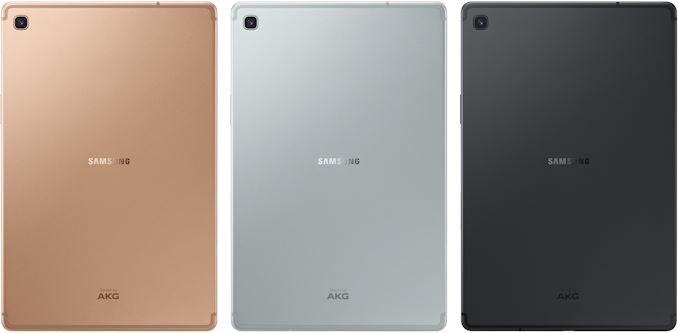Samsung Unveils Galaxy Tab S5e: 10.5-Inch sAMOLED with USB-C
by Anton Shilov on February 15, 2019 2:00 PM EST- Posted in
- Tablets
- Samsung
- Galaxy
- Android
- Galaxy Tab

Samsung today introduced its new mid-range Google Android-based tablet. Despite its formal positioning for consumers, the Galaxy Tab S5e features a rather large 10.5-inch sAMOLED display, a decent SoC, plenty of memory as well as storage, an advanced audio sub-system, a USB Type-C connector, and even compatibility with Samsung’s DeX platform for productivity applications. In general, the new tablet from Samsung brings together a decent performance, a good display, compatibility with productivity apps, compact dimensions, and a relatively low price - a rather interesting combination that we have not encountered before.
The Samsung Galaxy Tab S5e is powered by an unidentified SoC that integrates two 64-bit high-performance cores, six 64-bit energy-efficient cores, and an unknown iGPU. It is possible that the application processor was developed by Samsung itself, but at this point this is a speculation. The SoC is accompanied by 4 or 6 GB of DRAM and 64 or 128 GB of NAND flash storage (expandable by 512 GB using a microSDXC card). The tablet is outfitted with a 10.5-inch Super AMOLED display with a 2560×1600 resolution and thin bezels, similar to the one found on a considerably more expensive Galaxy Tab S4, but presumably without a stylus support. Imaging capabilities of the device comprise of a 13 MP rear sensor as well as an 8 MP front sensor.
When it comes to wireless connectivity features of the Galaxy Tab S5e, they include an 802.11ac Wi-Fi controller with MU-MIMO support, and Bluetooth 5.0. Samsung says that models with a 4G/LTE modem will be available later. Since the product is aimed at consumers, not road warriors, prioritizing the launch of Wi-Fi-only versions makes sense for the manufacturer. As for wired I/O, the Galaxy Tab S5e is outfitted with a USB 3.1 Type-C interface for audio, data, and charging, as well as a set of POGO connectors for keyboards or some other gear.
Like all good tablets these days, the Galaxy Tab S5e has a rather vast set of sensors, including an accelerometer, a gyroscope, a proximity sensor, a fingerprint scanner, a geomagnetic sensor (a compass), an RGB light sensor, and so on. The sensors can detect how the tablet is held (or placed) and then Samsung’s software automatically adjusts its quad-speaker audio sub-system co-designed with AKG for the best possible experience.
Designed primarily with consumers in mind, the Galaxy Tab S5e is very light and compact. It weights 400 grams and is just 5.5 mm thick, which is considerably lighter and thinner when compared to most 10-inch class tablets. Despite its rather humble z-height, the tablet packs a 7,040 mAh battery that provides up to 14.5 hours of battery life, according to the manufacturer.
| Samsung Galaxy Tab S5e | |
| Specifications | |
| SoC | 2 × high-performance cores at 2.0 GHz 6 × energy-efficient cores at 1.7 GHz |
| Graphics | unknown |
| Display | 10.5-inch sAMOLED 2560×1600 |
| Storage | 64 GB or 128 GB + microSD up to 512 GB |
| Memory | 4 GB or 6 GB LPDDR4 (?) |
| Wireless | Wi-Fi 802.11 a/b/g/n/ac 2.4G+5GHz, VHT80 MU-MIMO, Wi-Fi Direct, Bluetooth v5.0 |
| GPS | GPS, Glonass, Beidou, Galileo |
| Connectivity | USB 3.1 Type-C for data and charging POGO connectors for keyboard |
| Camera | Rear Camera: 13 MP Autofocus (?) Front Camera: 8 MP Fixed Focus (?) |
| Video | Recording: UHD 4K (3840×2160) @ 30fps Playback: UHD 4K (3840×2160) @ 60fps |
| Audio | 4 × Speakers co-developed with AKG with Dolby Atmos certification USB-C headset |
| Sensors | Accelerometer, Fingerprint Sensor, Gyro Sensor, Geomagnetic Sensor, Hall Sensor, RGB Light Sensor |
| Battery | 7040 mAh Up to 14.5 hours |
| Dimensions | 245 × 160 × 5.5 mm 400 grams (Wi-Fi) |
| Color | Silver, Black, Gold |
| OS | Android 9.0 Pie |
| Price | starts at $399.99 |
| Accessories | Book cover Keyboard, POGO Charging Dock, Slim cover, Book cover (not included) |
One interesting feature of the consumer-oriented Galaxy Tab S5e is its support for Samsung’s DeX platform that enables desktop-like experience on Android-based tablets (e.g., open up multiple windows, re-size windows, drag and drop content, etc.). Obviously, to take full advantage of DeX, users will need the optional Book Cover Keyboard that is sold separately. In the meantime, Samsung does not indicate that users may attach the tablet to a full-sized display using a USB Type-C to HDMI adapter if more screen real estate is needed, so this capability will likely remain exclusive to more expensive Galaxy Tab devices. Besides, the Galaxy Tab S5e also does not support Samsung’s Knox mobile security platform to protect valuable and confidential information, which is pretty logical given its positioning.
Samsung plans to start sales of its Galaxy Tab S5e in the second quarter of 2019 starting at $399.99. To increase the value of the product, Samsung will include a 4-months YouTube Premium subscription and a 3-months Spotify Premium subscription with the device (at least where available). 4G/LTE-enabled models will follow on later this year, their pricing is unknown.
Related Reading:
- Samsung Introduces Galaxy Tab S4: S835, 7300mAh Battery, Samsung DeX
- Acer Announces Chromebook Tab 10: A Tablet Running Google’s Chrome OS
- New High-End Android Tablets? Huawei MediaPad M5 gets Kirin 960
- Samsung Launches the 9.7-inch Galaxy Tab S3: Snapdragon 820 with 6000mAh and HDR
Source: Samsung












38 Comments
View All Comments
Xex360 - Friday, February 15, 2019 - link
The bezels are too thin for a tablet, having both a Nexus 10 and an 8" Huawei tablet with similar bezels to this one, the Nexus is much better especially for the size.Otherwise this tablet looks gorgeous, with a proper high resolution screen, 2k should be the standard resolution for any mobile device.
Jetcat3 - Friday, February 15, 2019 - link
Samsung’s own website is listing as the Qualcomm SDM 670. The website also shows video playback of 4K at 30 FPS. Last year y’all reported on the 670 with this, “The display controller also is less capable and only able to drive FHD+ resolutions as opposed to the QHD+ capabilitites of the 710.”Will this device be able to stream 2K videos off of YouTube then?
abufrejoval - Saturday, February 16, 2019 - link
I am constantly amazed, that tablets are given 2nd or 3rd grade SoCs.They should be much less sensitive to power consumptions, given that their screens need much bigger parts of the power budgets and they carry the bigger batteries to compensate.
Evidently even really power sucking SoCs like the Kirin 950 and 960, which were considered unseemly thirsty right here, evidently didn't cause problems in that form factor any more.
But I'd actually like to have a top-of-the line SoC in my next tablet, because I am much more likely to actually require it there for desktop usage.
Why do they sell overpowerd smartphones and underpowered tablets?
How does that make any sense?
Socius - Saturday, February 16, 2019 - link
No one’s going to point out how this is a literal design copy of the 2018 iPad Pro with the exception of the aspect ration and square lens vs round lens? Like total replica...bubblyboo - Sunday, February 17, 2019 - link
Or you know, the Tab S4, which was released earlier?Socius - Sunday, February 17, 2019 - link
Touché. I wasn’t aware of that. Cheers.ksec - Saturday, February 16, 2019 - link
I think ( guess ) Since Samsung ( Or Android in general ) aren't winning in the Tablet Space, they decide to just price the tablet it at the lowest possible. This is half the price of an 10.5" iPad Pro. And even thinner.Another reason, is that Samsung is an (nearly) fully integrated company. The decline of Smartphone has lots of consequence, from over supply of DRAM, NAND, Camera, Assembly, OLED... etc etc. All these needs to go somewhere. Not Operating in optimal capacity costs a lot. Both a Strength and Weakness of Samsung.
rubene66 - Saturday, February 16, 2019 - link
A crappy SDM 670 for $400 no thanks passdjayjp - Saturday, February 16, 2019 - link
So Snapdragon Cortex A75 and A55. Very impressive.LiverpoolFC5903 - Monday, February 18, 2019 - link
SD 670 is 2 CA A76 + 4 CA A55 -> Which implies it has better single threaded performance compared to higher models like 710/712, as the latter uses a A75 derivative core, which has lower ipc.Very balanced chipset. GPU is more than adequate at around SD 820 level and can play anything.